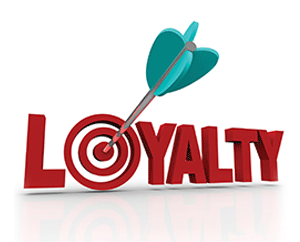Increasing sales and building stronger bonds with your customers. Are you the only game in town that offers the financial services that are available at your stores? Probably not. There are probably plenty of competitors in your stores’ neighborhoods.
Do you sell your services for less than everyone else? Also probably not. Most services available in the alternative financial sector are either fixed by regulation or market forces.
Do you offer services that your competitors do not? Again, the answer is probably “no” for the vast majority.
How Do You Stand Out from The Competition?
It’s called “Customer Experience.” And Customer Loyalty programs are a proven way to improve the Customer Experience. According to an article in Entrepreneur magazine, Starbucks’ customer-retention program played a key role in its 26 percent rise in profit and 11 percent increase in revenue during a fiscal quarter in 2013. To keep up with major online retailers like Amazon.com and eBay, Best Buy increased reward points from four percent to five percent last year to motivate customers to keep coming back. This strategy, along with additional changes, has helped that company’s stock more than double since early 2013.
Can Loyalty programs be effectively used by small businesses? A joint study by BIA/Kelsey and Manta of nearly 1,000 small business owners found they now spend more than half of their time and budget focused on existing customers. The report, titled “Achieving Big Customer Loyalty in a Small Business World,” reveals that for early adopters who already have a customer Loyalty program in place, 64 percent of them report it’s been effective, meaning that it makes more money than it costs to maintain. It’s important for business owners to keep in mind that customer Loyalty isn’t just for big businesses – a well-designed program can help any size business.
Loyalty or Reward programs have been around for nearly as long as people have exchanged goods to encourage continued patronage by their customers. Consider the farmer who would throw in an extra ear of corn for his good customers. S&H Green Stamps, originating in the early 19th century, created the concept of using stamps earned as a reward and then exchanged for items of value. Today, points are often used as digital currency. This concept has its roots in the first Frequent Flyer program that earned “miles” for distance traveled on American Airlines flights, dating back to 1981.
Modern Loyalty or Rewards programs have their roots in the early 1990s and were developed as a way to create differentiation. As many retail models began to move into self-service modes, they lost personal contact with their customers. Additionally, the brands available were not usually unique to a retailer and consumers began to view products as commodities, often just seeking the store with the best price. Furthermore, advances in technology allowed savvy retailers to study purchasing trends and identify different patterns in various consumer behaviors. This allowed for segmenting customers by their purchase habits, thus resulting in the ability to design rewards for certain behaviors rather than just transactions.
Engaging Your Customers
The most important component of any Loyalty program is customer engagement. Successful programs engage customers at three levels.
First, is at the introduction. Getting the customer to join your Loyalty program is the natural first step. Why not reward them for that and give them a taste of the rewards with their first transaction? Get 500 points – just for signing up – is a strong initial engagement.
Second, use your data on customers to segment them into different groups based on their behavior. Frequent customers can be rewarded not just for their purchases but also for their dedication to your brand. Offer them rewards for new customer referrals. Infrequent customers, on the other hand, can be offered rewards for incremental visits or purchases, while monthly customers like those who have enrolled in your benefits direct deposit program can be notified when checks are available for pickup. These incentives also facilitate harvesting of email addresses or text message opt-ins for future communications.
The third way to engage may not be with communications about transactions or visits at all. It could center around “insider” information only available or released early to Reward Program Members. It could be regarding a new store opening, a new product release, a change in pricing policies or any other activity that would be of interest and make them feel special.
With today’s technologies, successful retailers can have old fashioned two-way conversations with their customers, extending the special bond created beyond just store visits. Loyalty programs are a proven method of increasing sales and building stronger bonds with your customers.

